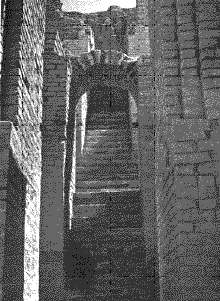|
|
Triglyphs are thick grooved panels that help
support the weight of the structure above. Metopes are thinner panels that do no work in holding
up the temple and hence invite decoration in the
form of painting or sculpture.
Overhanging the parts below is the decorative
cornice molding. Like an eave it helps keep rainwater clear of the building. Above the horizontal
cornice a low, pitched roof rises to produce a
triangular pediment at either end of the temple.
Sculpture fills the pediments of many Doric
temples. The simplicity of the Doric order clearly
emphasizes the structural function of each part.
Originally, paint also enlivened its surfaces.
Architectural elements (especially in the entablature)
were often painted deep red, yellow-gold, white, or blue.
Ionic order:
The Ionic order is distinguished from the Doric
primarily by its column and frieze. The Ionic
column rests on an elaborate curving base rather than
directly on the stylobate. The column shaft
usually has deeper flutes and is more slender than
the Doric. The height-to-base ratio of early Ionic
columns was 8 to 1, compared with a ratio between 4 to 1 and 6 to 1 for Doric columns. The
typical Ionic capital has two spiral
volutes, elements that resemble partly unrolled scrolls. These straddle
a small band at the top of the shaft, usually
carved with an elaborate decorative pattern. The
Ionic capital looks different from the sides than from
the front or back. This difference caused problems
in columns that stood at the corners, where
volutes had to slant at a 45-degree angle so that their
spiral pattern would look the same from the front
of the temple as from the sides.
|
|
The Ionic architrave, unlike the plain Doric
architrave, consists of three narrow bands. The
frieze above it is often decorated with sculpture and
is continuous, not divided into triglyphs and
metopes as in the Doric order. Multiple rows of
moldings decorate the Ionic cornice. They are
generally carved in more intricate patterns than in Doric
entablatures, and may include a row of square
"teeth" called dentils. Over all, Ionic is a more
ornamental and graceful style than Doric, but it lacks
the clarity and power of the Doric style. As a
result, ancient critics regarded the Doric order as
masculine and the Ionic as feminine. Even so,
architects used the Ionic order not only for small,
delicate buildings such as the Treasury of the Siphnians at Delphi (525? B.C.), but also for
more monumental structures. In fact, the first
colossal Greek temples were Ionic—the Temple of Hera
on the island of Sámos and the Temple of Artemis
at Ephesus (both under construction by about 560 B.C.). Both featured double rows of Ionic
columns, and were gigantic—the temple at Ephesus
measured 112 m (366 ft.) in length, with columns
some 18 m (60 ft.) tall. Although Doric and Ionic are
often considered mutually exclusive regional
styles, some buildings combined features of both orders.
Corintian order:
The Corinthian order resembles Ionic in most
aspects, but Corinthian columns have tall capitals shaped like an upside-down bell and are
covered with rows of acanthus leaves and small vine
like spirals called helixes. The first known
Corinthian column stood alone inside the cella of the
Temple of Apollo Epicurius at Bassae (429?-405?
B.C.). Indeed, the Corinthian order was at first used
only for columns inside buildings—it did not appear
externally until the 4th century B.C..
|
|
































































































